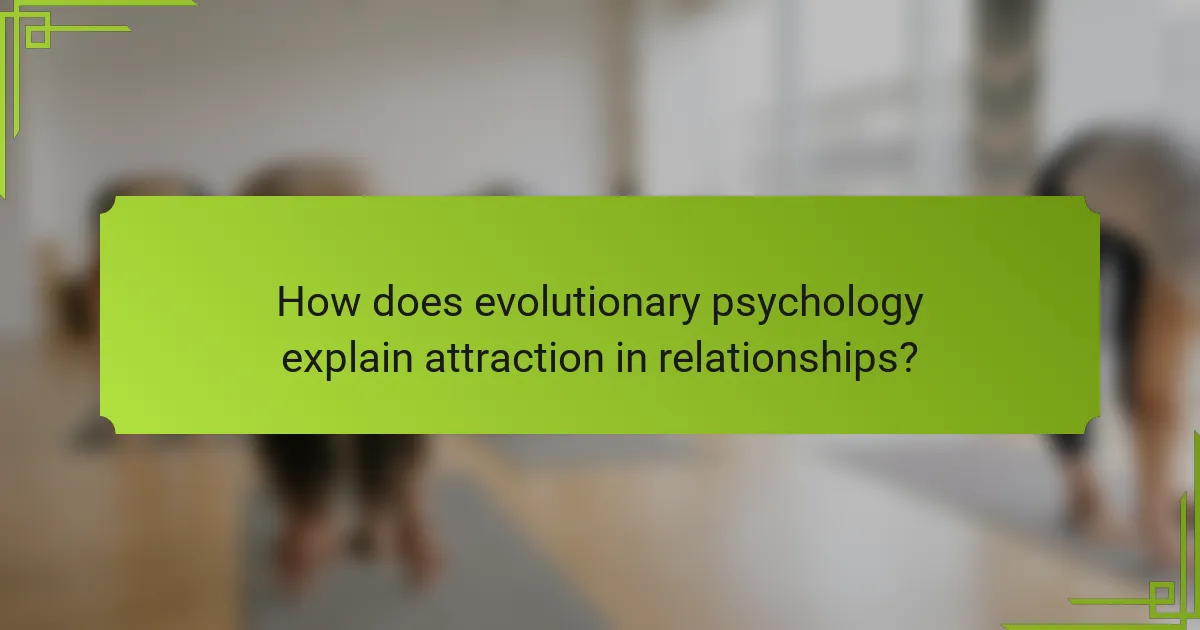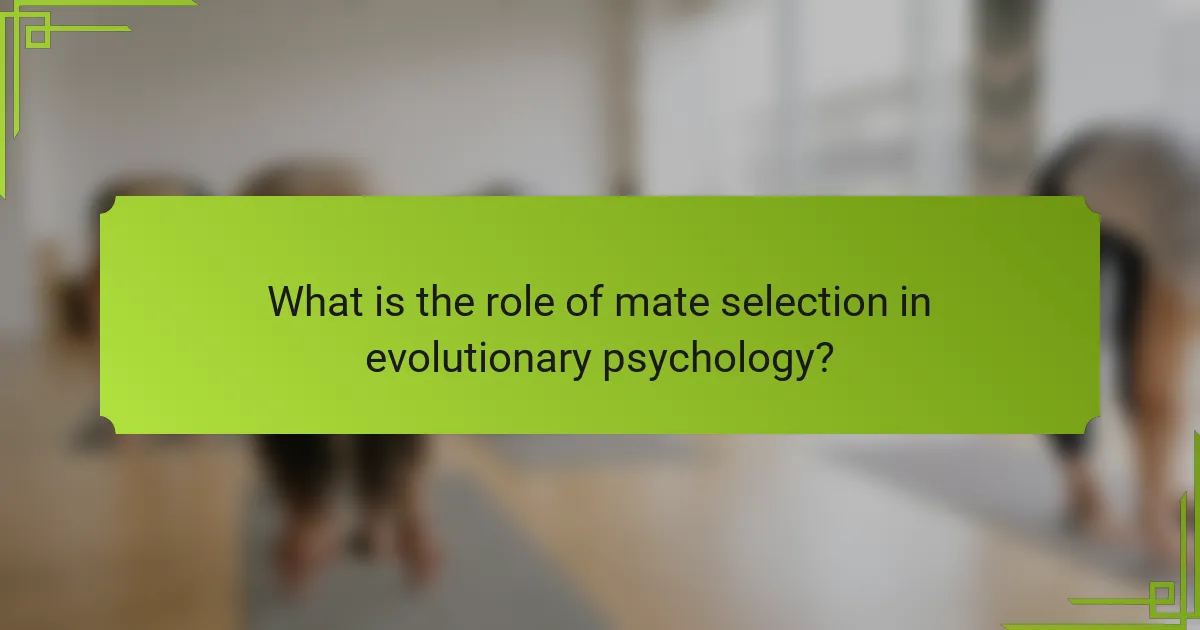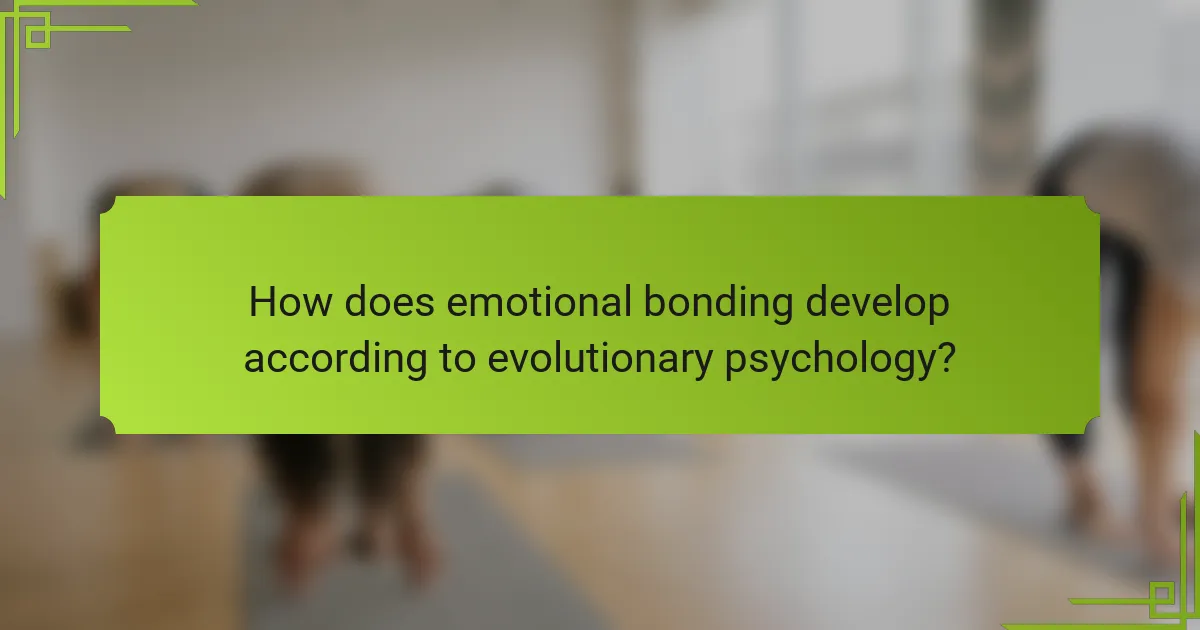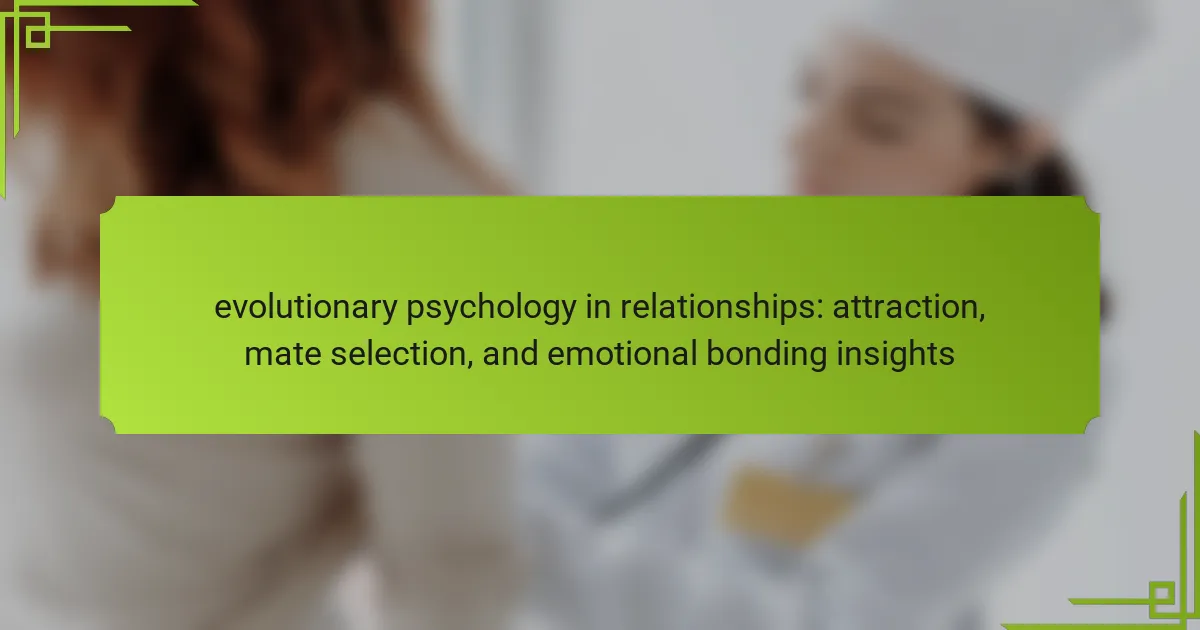Understanding the dynamics of attraction, mate selection, and emotional bonding can enhance relationship satisfaction. Evolutionary psychology reveals how natural selection shapes partner preferences and bonding experiences. This framework explores traits signaling genetic fitness, the role of attachment styles, and the neurobiological mechanisms behind emotional connections. Insights from this field can inform modern relationship practices and improve interpersonal connections.

How does evolutionary psychology explain attraction in relationships?
Evolutionary psychology explains attraction in relationships as a mechanism shaped by natural selection. It highlights mate selection based on traits signaling genetic fitness, such as physical appearance and social status. Emotional bonding is influenced by attachment styles, which evolved to enhance reproductive success. This framework suggests that preferences in partners arise from ancestral environments where survival and reproduction were paramount. Understanding these dynamics can provide insights into modern relationship patterns and behaviours.
What are the universal principles of attraction?
The universal principles of attraction include physical appearance, proximity, similarity, and reciprocal liking. These factors influence mate selection and emotional bonding in evolutionary psychology. Physical appearance often serves as an initial filter in attraction, while proximity facilitates interactions. Similarity in values and interests enhances compatibility. Reciprocal liking fosters emotional connections, reinforcing attraction. Understanding these principles can provide insights into relationship dynamics and mate choices.
How do physical traits influence attraction?
Physical traits significantly influence attraction by serving as visual cues for genetic fitness and health. Evolutionary psychology suggests that individuals are drawn to traits indicating reproductive viability. For example, symmetry, clear skin, and physical fitness are often perceived as attractive because they signal good genes.
Research indicates that these traits can trigger emotional bonding and mate selection processes. Studies show that people tend to favour partners with traits that align with their own genetic predispositions, enhancing compatibility. This unique attribute of physical traits in the context of attraction plays a crucial role in forming lasting relationships.
In summary, physical traits function as essential indicators in the evolutionary psychology of attraction, guiding mate selection and fostering emotional connections.
What role does personality play in attraction?
Personality significantly influences attraction by shaping perceptions and emotional connections. Traits such as kindness, humour, and confidence often enhance desirability. Research indicates that individuals with agreeable personalities tend to be more attractive as partners, fostering deeper emotional bonds. Evolutionary psychology suggests these traits signal reproductive fitness and social compatibility, crucial for mate selection.
What unique factors affect attraction in different cultures?
Cultural factors significantly influence attraction, affecting mate selection and emotional bonding. Individual preferences are shaped by societal norms, traditions, and values. For instance, collectivist cultures prioritise family and community input in relationships, while individualistic cultures emphasise personal choice and romantic love. Unique attributes like beauty standards vary widely; some cultures value body size, while others prioritise facial symmetry. Additionally, emotional expression differs; cultures with high-context communication may value subtlety, whereas low-context cultures favour directness. Understanding these factors is crucial for navigating cross-cultural relationships effectively.
How does social status impact attraction?
Social status significantly influences attraction by shaping perceptions of desirability. Higher social status often correlates with traits like confidence and resources, enhancing attractiveness. Research indicates that individuals with elevated social standing are perceived as more desirable partners, impacting mate selection. This dynamic reflects evolutionary psychology principles, where social status serves as a signal of genetic fitness and resource availability, ultimately affecting emotional bonding in relationships.
What are the effects of cultural norms on attraction preferences?
Cultural norms significantly shape attraction preferences by influencing what individuals find desirable in potential partners. These norms dictate standards of beauty, behaviours, and values that vary across societies. For example, collectivist cultures often prioritise harmony and family approval in mate selection, while individualistic cultures may emphasise personal fulfilment and romantic love.
Research indicates that these preferences can shift over time as cultural contexts evolve, impacting emotional bonding strategies. Unique attributes like socio-economic status and educational background may also play a role in attraction, reflecting cultural values. The interplay between cultural norms and attraction preferences highlights the complexity of human relationships within the framework of evolutionary psychology.
What are some rare traits that can enhance attraction?
Rare traits that can enhance attraction include uniqueness, confidence, and emotional intelligence. Uniqueness captivates attention and fosters curiosity. Confidence signals stability and security, making individuals more appealing as partners. Emotional intelligence allows for deeper connections and understanding, enhancing bonding. These traits, while not commonly emphasised, can significantly influence mate selection and relationship dynamics.
How do uncommon interests influence attraction?
Uncommon interests can enhance attraction by fostering deeper emotional connections. Shared unique passions create a sense of intimacy, signalling compatibility. This aligns with evolutionary psychology, which suggests that mate selection often hinges on distinctive traits that stand out. Such interests can also indicate resourcefulness and creativity, traits valued in long-term partnerships. Engaging in uncommon activities together may strengthen bonding and reinforce relationship stability.
What is the impact of evolutionary mismatches on attraction?
Evolutionary mismatches can significantly distort attraction, leading individuals to prefer traits not aligned with modern relationship dynamics. These mismatches arise when ancestral preferences clash with contemporary social contexts, affecting mate selection and emotional bonding. For example, a preference for high-status partners may overlook emotional compatibility, resulting in dissatisfaction. As a result, understanding these mismatches is crucial for navigating modern relationships effectively.

What is the role of mate selection in evolutionary psychology?
Mate selection plays a crucial role in evolutionary psychology by influencing reproductive success and genetic diversity. Individuals choose partners based on traits that signal health, fertility, and resources. This selection process shapes emotional bonding and attraction, fostering long-term relationships that enhance survival and offspring viability. For example, studies show that physical attractiveness often correlates with perceived genetic fitness. Additionally, mate preferences vary across cultures, reflecting unique environmental adaptations. Understanding these dynamics provides insights into human behaviour and relationship formation.
How do evolutionary theories explain mate selection processes?
Evolutionary theories suggest that mate selection processes are influenced by biological and psychological factors aimed at maximizing reproductive success. Key concepts include sexual selection, where individuals choose mates based on traits signaling genetic fitness, and parental investment, which emphasizes the importance of nurturing offspring.
Attraction often hinges on physical characteristics, social status, and resources, as these attributes indicate potential for successful reproduction. Emotional bonding plays a critical role, fostering long-term partnerships that enhance offspring survival.
Unique attributes of evolutionary psychology highlight the adaptive nature of these processes, as preferences can vary across cultures and contexts. For example, preferences for certain physical traits may reflect local environmental conditions and resource availability.
Overall, evolutionary theories provide a framework for understanding the complexities of mate selection, revealing how biological imperatives shape human relationships.
What are the key criteria individuals use for mate selection?
Individuals prioritize physical attractiveness, social status, compatibility, and emotional stability when selecting a mate. Physical attractiveness often serves as an initial filter, while social status can indicate resource availability. Compatibility, including shared values and interests, fosters long-term connection. Emotional stability is crucial for relationship resilience. These criteria reflect evolutionary psychology principles, emphasizing traits that enhance reproductive success and partnership longevity.
How does the concept of genetic fitness influence choices?
Genetic fitness significantly influences choices in relationships by guiding mate selection and attraction. Individuals often seek partners who exhibit traits associated with high genetic fitness, such as physical health and genetic diversity. This preference enhances the likelihood of producing viable offspring, thereby increasing evolutionary success. For example, research shows that physical attractiveness is often linked to perceived genetic quality, affecting emotional bonding and relationship dynamics. As a result, the concept of genetic fitness shapes not only personal preferences but also broader social patterns in mate selection.
What unique strategies do individuals employ in mate selection?
Individuals employ unique strategies in mate selection by prioritizing traits that signal genetic fitness and compatibility. These strategies often include assessing physical appearance, social status, and personality traits. Research indicates that individuals may use evolutionary cues, such as symmetry and health indicators, to make judgments about potential partners. Additionally, emotional bonding is influenced by shared values and experiences, enhancing long-term relationship stability.
How do online dating platforms alter mate selection dynamics?
Online dating platforms significantly alter mate selection dynamics by broadening access to potential partners. These platforms leverage algorithms that match users based on preferences and behaviours, enhancing the efficiency of attraction and selection processes.
As a result, individuals can evaluate more options, leading to a shift in traditional mate selection criteria. Users often prioritize attributes such as physical appearance and shared interests, which are prominently displayed on profiles. This focus on visual and superficial traits can influence emotional bonding, sometimes overshadowing deeper compatibility factors.
Moreover, the anonymity and distance provided by online platforms allow users to explore different types of relationships without immediate social repercussions. This unique attribute of online dating fosters experimentation in mate selection, as individuals may pursue connections they might not consider in face-to-face interactions.
In summary, online dating platforms reshape mate selection by expanding choice, emphasizing specific attributes, and encouraging diverse relationship explorations.
What role does competition play in mate selection?
Competition plays a significant role in mate selection by influencing preferences and choices. Individuals often assess potential partners based on their perceived desirability compared to others. This dynamic fosters traits that enhance attractiveness, such as confidence and resources. Research indicates that competition can lead to increased effort in mate attraction strategies. For example, men may invest more in status or appearance when competing for female attention. This competitive nature ultimately shapes emotional bonding by creating a sense of urgency and value in relationships.
What are some rare mate selection patterns observed in specific populations?
Certain populations exhibit rare mate selection patterns that challenge conventional evolutionary psychology insights. For instance, some cultures prioritize familial alliances over individual preferences, leading to arranged marriages. In isolated communities, mate selection may focus on genetic diversity to avoid inbreeding, resulting in unique pairing criteria. Additionally, societies with matrilineal structures often see women selecting partners based on resource availability and social status, contrasting with patriarchal norms. These patterns highlight the influence of cultural context on attraction and emotional bonding, revealing the complexity of human relationships.
How do polyamorous relationships challenge traditional mate selection?
Polyamorous relationships challenge traditional mate selection by introducing multiple partners into the emotional bonding process. This dynamic alters attraction patterns, where individuals may prioritize emotional connections over societal norms. Research indicates that polyamory can lead to enhanced communication skills and a broader understanding of love. As a result, individuals in polyamorous relationships often experience increased satisfaction and reduced jealousy compared to monogamous counterparts. This shift in mate selection reflects evolving societal values surrounding relationships and emotional fulfilment.
What unique mate selection behaviors are seen in isolated communities?
Isolated communities often exhibit unique mate selection behaviors influenced by cultural and environmental factors. These behaviors may include preference for kinship ties, as individuals often select partners within their extended family or close social networks. Limited genetic diversity can lead to a focus on traits that enhance local adaptation, such as resilience to specific environmental conditions.
In these communities, traditional practices and rituals play a significant role in mate selection. For example, arranged marriages may be more prevalent, emphasizing familial approval and social stability. Additionally, isolation can lead to distinct courtship rituals that reflect local customs and values, enhancing emotional bonding through shared cultural experiences.
Overall, the unique mate selection behaviors in isolated communities highlight the interplay between evolutionary psychology and cultural influences, shaping attraction and relationship dynamics.

How does emotional bonding develop according to evolutionary psychology?
Emotional bonding develops through evolutionary psychology as a mechanism for enhancing reproductive success. This bonding fosters trust and cooperation between partners, critical for raising offspring.
Root attributes of emotional bonding include attachment styles and mutual support. Unique attributes involve the role of shared experiences in strengthening connections. Rare attributes may consist of the impact of pheromones on attraction and bonding.
Research indicates that emotional bonds activate brain regions associated with reward and pleasure, reinforcing pair bonding. This neurobiological response encourages long-term commitment, essential for survival and reproductive success.
Overall, evolutionary psychology illustrates that emotional bonding is not just a social construct but a fundamental aspect of human relationships, shaped by natural selection.
What are the universal components of emotional bonding?
Emotional bonding universally comprises attachment, trust, intimacy, and shared experiences. These components foster deep connections and enhance relationship satisfaction. Attachment forms a secure base, while trust ensures emotional safety. Intimacy promotes vulnerability, and shared experiences create lasting memories. Together, they strengthen relational ties and influence mate selection.
How do attachment styles influence emotional bonding?
Attachment styles significantly influence emotional bonding by shaping how individuals connect and communicate in relationships. Secure attachment fosters trust and intimacy, while anxious or avoidant styles can lead to misunderstandings and emotional distance. Research indicates that secure individuals are more likely to engage in healthy conflict resolution and express their needs openly, enhancing emotional bonds. In contrast, anxious individuals may seek constant reassurance, potentially overwhelming their partners, while avoidant individuals often withdraw, hindering deep connections. Understanding these dynamics can improve relationship satisfaction and emotional closeness.
What is the significance of shared experiences in bonding?
Shared experiences significantly enhance bonding by fostering emotional connections and mutual understanding. These experiences create a sense of belonging and shared identity, which are crucial in mate selection and attraction. Research indicates that couples who engage in novel activities together report higher relationship satisfaction, as these experiences stimulate dopamine release, reinforcing emotional ties. The unique attribute of shared experiences lies in their ability to transform individual perspectives into a collective narrative, strengthening the bond over time.
What unique emotional bonding behaviours are influenced by evolutionary factors?
Unique emotional bonding behaviours influenced by evolutionary factors include attachment, nurturing, and mate guarding. These behaviours enhance relationship stability and reproductive success. For instance, attachment fosters security, while nurturing promotes offspring survival. Mate guarding ensures fidelity, enhancing genetic continuity. These behaviours reflect deep evolutionary roots, shaping human emotional connections.
How does parental investment shape emotional bonds?
Parental investment significantly influences emotional bonds by fostering attachment and security in relationships. Investment in offspring enhances trust and connection, driving mate selection and attraction dynamics. Research indicates that higher parental involvement correlates with stronger emotional ties, reflecting a unique attribute of evolutionary psychology. This investment shapes not only the parent-child relationship but also the adult romantic partnerships formed later in life. As a result, understanding these dynamics offers valuable insights into relationship formation and maintenance.
What role does oxytocin play in emotional bonding?
Oxytocin plays a crucial role in emotional bonding by enhancing trust and attachment between individuals. This hormone promotes feelings of closeness and intimacy, which are essential for forming strong relationships. Research indicates that oxytocin levels increase during positive social interactions, such as hugging or bonding experiences. Furthermore, it influences mate selection by reinforcing emotional connections, making partners more committed to each other. This unique attribute of oxytocin highlights its evolutionary significance in fostering long-term relationships and cooperative parenting.
What are some rare emotional bonding phenomena in relationships?
Rare emotional bonding phenomena in relationships include shared trauma, synchronized heart rates, and emotional mirroring. These unique attributes can deepen connections, enhancing mutual understanding and empathy. Shared trauma often leads to stronger bonds as partners navigate challenges together. Synchronized heart rates during intimate moments can create a profound sense of unity. Emotional mirroring, where partners subconsciously reflect each other’s emotions, fosters intimacy and strengthens attachment. These phenomena illustrate the complex interplay of evolutionary psychology in mate selection and emotional bonding.
How do long-distance relationships affect emotional bonds?
Long-distance relationships can strengthen emotional bonds through increased communication and intentionality. Partners often engage in deeper conversations, enhancing intimacy. Research indicates that couples who navigate distance develop stronger commitment levels, as they actively work to maintain their connection. This effort can lead to a unique bond, characterised by trust and emotional resilience.
What unique bonding experiences arise in high-stress situations?
High-stress situations can create unique bonding experiences by fostering vulnerability and shared emotional responses. These moments often lead to increased trust and deeper connections between individuals. Research indicates that adrenaline and shared challenges enhance attraction and emotional bonding. For example, couples facing adversity together often report stronger relationships. This phenomenon aligns with evolutionary psychology, suggesting that cooperation in stressful contexts strengthens mate selection and emotional ties.

What actionable strategies can enhance attraction, mate selection, and emotional bonding?
To enhance attraction, mate selection, and emotional bonding, focus on these actionable strategies. Prioritise effective communication to express needs and desires clearly. Foster shared experiences to build intimacy and connection. Cultivate empathy by actively listening and validating feelings, creating a supportive environment. Maintain physical touch to strengthen emotional bonds through non-verbal cues. Recognise and appreciate partner qualities, reinforcing positive reinforcement in the relationship.
What best practices can individuals apply to improve their relationship outcomes?
To improve relationship outcomes, individuals should apply best practices rooted in evolutionary psychology. Focus on enhancing emotional bonding, understanding mate selection cues, and fostering attraction through shared experiences and effective communication.
Building strong emotional connections involves active listening and expressing vulnerability. Recognising evolutionary signals, such as physical attractiveness and social status, can influence mate selection. Engaging in activities that promote mutual interests strengthens the bond and increases relationship satisfaction.
Prioritising open communication helps in resolving conflicts and understanding partner needs. Developing empathy allows individuals to navigate emotional challenges more effectively.
Lastly, maintaining individual identities while nurturing the relationship fosters a healthy balance, promoting long-term success.
What common mistakes should be avoided in the context of relationships?
Avoiding common mistakes in relationships is crucial for fostering attraction, mate selection, and emotional bonding. Key errors include neglecting communication, failing to understand partner needs, and misinterpreting signals of affection.
Poor communication can lead to misunderstandings, diminishing emotional connection. Ignoring individual needs undermines mate selection, as partners may feel unvalued. Misinterpreting affectionate gestures can create unnecessary conflict, impacting overall relationship satisfaction.
Recognising these pitfalls can enhance relationship dynamics, promoting healthier interactions and deeper emotional bonds.
How can understanding evolutionary psychology optimize relationship dynamics?
Understanding evolutionary psychology can significantly enhance relationship dynamics by revealing underlying motivations in attraction, mate selection, and emotional bonding. Insights from evolutionary psychology highlight how individuals are often driven by innate biological imperatives. For instance, preferences for certain traits in partners can be traced back to ancestral survival strategies.
Attraction often stems from evolutionary signals, such as physical health indicators, which suggest genetic fitness. Mate selection is influenced by factors like social status and resource availability, reflecting ancestral environments where these traits ensured survival and reproductive success. Emotional bonding is fostered through mechanisms like attachment styles, which can be understood through evolutionary lenses that prioritize long-term partnerships for child-rearing.
By applying these insights, individuals can navigate relationship dynamics more effectively, fostering healthier connections and reducing conflict. Recognising the evolutionary roots of behaviours can lead to greater empathy and understanding between partners, ultimately optimizing relationship satisfaction.
